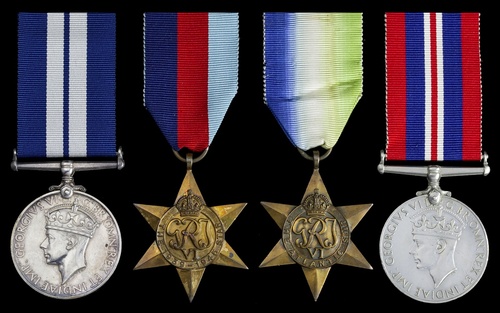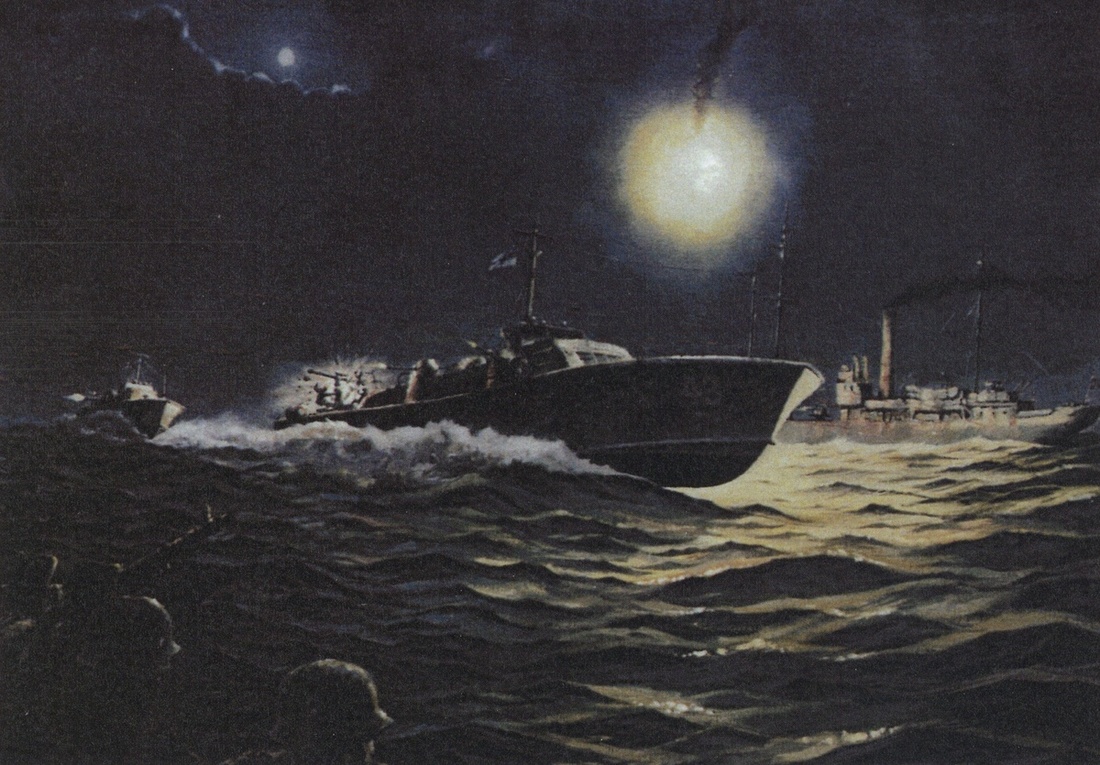Auction: 19001 - Orders, Decorations and Medals
Lot: 529
An outstanding Second Word War Coastal Forces' immediate D.S.M. group of four awarded to Leading Seaman E. Fletcher, Royal Navy, who was decorated for his gallantry as a gunner in M.T.B. 43 in a Channel firefight on the night of 3-4 March 1942
His skipper, Lieutenant Stewart Gould, D.S.C., was already emerging as one of Coastal Forces' most aggressive flotilla leaders and - just three weeks earlier - had won his second D.S.C. for a brazen daylight attack on the Scharnhorst, Gneisenau and Prinz Eugen during the Channel Dash: on that occasion Fletcher shot down a Me. 109
He was subsequently killed in action off Normandy in June 1944, when his landing craft - H.M. L.C.(H.) 185 - detonated an acoustic mine
Distinguished Service Medal, G.VI.R. (SSX. 25427 E. Fletcher, A.B.), impressed naming; 1939-45 Star; Atlantic Star; War Medal 1939-45, good very fine (4)
D.S.M. London Gazette 21 April 1942:
'For gallantry, skill and endurance while serving in H.M. Torpedo Boats in action against the enemy.'
The original recommendation states:
'This rating has several times done excellent work as Oerlikon gunner. On 12 February 1942, he shot down a Messerschmitt 109. He showed particular skill and initiative on the night of 3 March 1942, when in action with E-Boats and Flak ships.'
Eric Fletcher likely joined M.G.B. 43 on her re-designation in early 1941; she had been destined for the Royal Norwegian Navy and would be converted for use as a Motor Torpedo Boat (M.T.B.) in early 1942.
Commanded by Lieutenant Stewart Gould, R.N., M.G.B. 43 would see considerable action in the same period, largely owing to the daring nature of her skipper: he won a brace of D.S.C.s during his time as C.O. of the 3rd M.G.B. Flotilla, the second of them for a gallant attempt to penetrate the enemy's defensive screen in M.G.B. 43 during the famous Channel Dash of February 1942, a memorable action in which Fletcher distinguished himself.
First firefight - serious wounds
However, M.G.B. 43 fought her first major action on the night of 8-9 September 1941, in the Straits of Dover, off Cap Blanc Nez, operating alongside her consort, M.G.B. 52, and a flotilla of M.T.B.s. Bryan Cooper's history - The Battle of the Torpedo Boats - takes up the story:
'Fifteen miles away, the gunfire was seen by Lieutenant Stewart Gould from the bridge of M.G.B. 43. Together with M.G.B. 52, commanded by Lieutenant Barry Leith, R.N.V.R., this boat was racing towards the interception, having received a bearing from Dover Command headquarters. The boats altered course slightly to head directly for the lights flashing over the distant horizon ... As Gould headed for the distant gunfire, he too was wondering if now, at last, they were to have their chance. It would be galling for the M.T.B.s to have it all their own way; at this time there existed a friendly rivalry between the crews serving in the two types of craft ...The first to actually sight the convoy was Gould, in M.G.B. 43. He signalled the information to Dover Command and also to Pumphrey [Flotilla C.O. of the M.T.B.s].
As far as Gould could make out, there was one merchant ship and about six escorts, two of them armed trawlers and the remainder E-Boats. He decided to shadow the convoy until the M.T.B.s had time to close for their attack, and took station on the port quarter, about three-quarters of a mile behind. But the minutes passed and there was still no sign that the M.T.B.s had seen the convoy. All Gould knew was that they were several miles to the west. At 01.40, he decided to make a depth charge attack with the dual purpose of inflicting as much damage to the enemy as he could and also guiding the M.T.B.s to the area. Just at that moment, however, he saw small craft coming up astern of the convoy at high speed. It wasn't where he expected to see the M.T.B.s, but they could have changed their position.
'Thinking they might be our M.T.B.s,' Gould later reported, 'I challenged. This was answered by heavy and accurate fire from shell-firing machine-guns. I then saw they were German S-Boats [E-Boats], four of them, in line abreast.'
Both of Gould's Lewis gunners, Able Seamen S. J. Beckett and E. Fletcher, were severely wounded by fragments of cannon shell, so that they were unable to take any further part in the action. M.G.B. 52 following, increased speed to 30 knots and engaged the enemy S-Boats with full armament. Turning north, he then raced across the bows of the leading German boat and dropped a depth charge, set to go off at 100 feet. There was a dull explosion and no more was seen of the S-Boat. Meanwhile, the other German boats were being repeatedly hit with Oerlikon and Lewis gun fire, and after a couple of minutes they broke off the action and turned away to the south at high speed. Gould then set about the rest of the convoy, closing to within 600 yards and engaging with gunfire. The enemy were so demoralised by now that they were firing wildly in all directions, and at one point, as Gould later recalled, the trawlers were firing at their own S-Boats ... the M.G.B.s broke off the engagement at 02.55 and set course for home ... On the way home, a Dornier 17 shadowed the two craft for about twenty minutes at a height of 500 feet. The plane was finally driven off by 43's gunner, Able Seaman Lanfear. M.G.B. 43 finally arrived at Ramsgate at 09.20, after [the damaged] M.G.B. 52 had been taken in tow by a destroyer.'
Gould was awarded the D.S.C. and Able Seaman Leslie Lanfear the C.G.M.; another rating, James Tate, was awarded the D.S.M.
Channel Dash
Fletcher re-joined M.G.B. 43 on recovering from his wounds and saw further action under Stewart Gould's aggressive tenure of command, not least in the Channel Dash on 12 February 1942, when the Scharnhorst, Gneisenau and Prinz Eugen broke out of Brest. In common with a flotilla of M.T.B.s under Lieutenant-Commander E. N. Pumphrey, D.S.O., D.S.C., Gould was called to action with minimal notice. His somewhat tardy arrival on the scene was nonetheless timely, as Pumphrey's boats were facing-off an enemy Narvik-class destroyer. Peter Scott's Battle of the Narrow Seas takes up the story:
'Stewart Gould was hopping mad ta having missed all the fun. He had shot down two Messerschmitt's on his way across [one of them downed by Fletcher], which had slightly soothed him, but he was in no mood to be embarrassed by a mere Narvik. The two 63-foot boats went bald-headed for the destroyer, blazing away with their single Oerlikon guns. They intended to attack with depth charges. The German unit must have taken them for fresh M.T.B.s still complete with torpedoes, for he turned away and rejoined his main force. The only other bright spot in this very sombre day was that on our way back M.T.B. 45 was able to pick up two of the very gallant airmen from the Swordfish, whose attack is one of the most splendid episodes in our Naval history.'
One of the enemy aircraft - a 109 - was downed by Fletcher. For M.G.B. 43's most gallant head-on attack against the Narvik-class destroyer, Gould was awarded a Bar to his D.S.C.
Immediate D.S.M.
A little under three weeks later - on the night of 3 March 1942 - Fletcher won his D.S.M. in a classic Coastal Forces' firefight against an enemy convoy off Cap Gris Nez.
On that occasion, with M.G.B. 41 and a force of M.T.B.s in company, Gould entered the fray with typical gusto, so much so that he and his consort inadvertently penetrated to the landward side of the convoy and incurred the full wrath of 'a large number of shore guns'. His official report speaks of 'exceedingly intense and accurate fire … several heavy shells fell very close … Boats were covered in spray and lights were put out in M.G.B. 43 and other minor damage sustained. It must be counted very lucky that neither Boat received direct hits … '
On clearing the shore batteries, Gould ran into three E-Boats and a four-minute firefight ensued, accurate work by Fletcher on M.G.B. 43's Oerlikon inflicting damage on the latter.
Whether Fletcher was still serving in M.T.B. 43 at the time of her demise on the night of 17-18 August 1942 remains unknown. More certain is the fact he received his well-merited award of the D.S.M. at an investiture held on 29 September 1942.
Journey's end - Normandy, June 1944
In common with other Coastal Forces' personnel, he subsequently transferred to landing craft duties in readiness for the Normandy landings. It was in this capacity - as a Leading Seaman in H.M. L.C. (Headquarters) 185 - that he participated in the D-Day landings on Sword beach, when she disembarked 30 'amphibian tanks' and 27 Naval Commandos.
L.C. (H.) 185 was still employed off Normandy on Sunday, 25 June 1944, when she detonated an acoustic mine off Lion-sur-Mere, with a loss of 25 men. Fletcher, aged 24, was among them and left a widow, Kathleen. He has no known grave and is commemorated on the Portsmouth Memorial.
Cataloguer's note:
In June 2018, a memorial stone was unveiled off Lion-sur-Mere, 94-year old Patrick Thomas - 185's sole survivor - having told the local Mayor he would like to hear 'The Last Post' on the same occasion: a bugler was duly present.
Subject to 20% VAT on Buyer’s Premium. For more information please view Terms and Conditions for Buyers.
Sold for
£4,500







